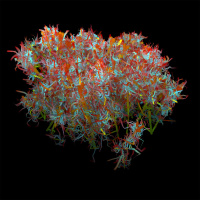The Face of Spam
 Wednesday, April 2, 2008
Wednesday, April 2, 2008  Uugh.. who would want to look at anything remotely representative of two of the most hideously ugly realities of online life?
Uugh.. who would want to look at anything remotely representative of two of the most hideously ugly realities of online life?
Alex Dragalescu, that's who. Dragalescu, a Romanian visual artist, often uses analyses of spam and other annoyances to drive visualization schemes, producing highly-organic-looking computer-generated images. (And, in this case, a nice example of meta-imagery: CGI's of nasty things that see their birth, and are spread, via computers.)
For example, Alex uses "the ASCII values found in the text of spam messages determine the attributes and qualities of the Spam Plants."
The graphic in this post is from Spam plants.
His latest series is entitled Malwarez, which is
a series of visualization of worms, viruses, trojans and spyware code. For each piece of disassembled code, API calls, memory addresses and subroutines are tracked and analyzed. Their frequency, density and grouping are mapped to the inputs of an algorithm that grows a virtual 3D entity. Therefore the patterns and rhythms found in the data drive the configuration of the artificial organism.
This is all fascinating, fractal stuff, and is in the spirit of other visualization projects posted on fractalog.








